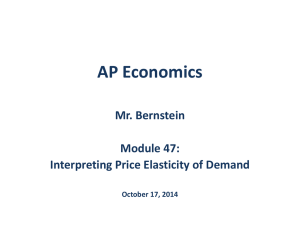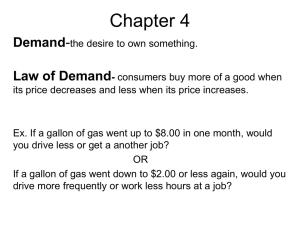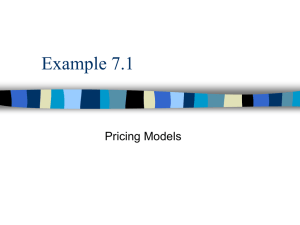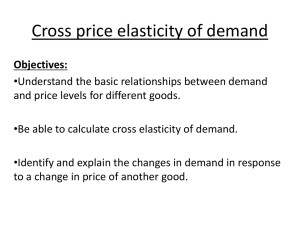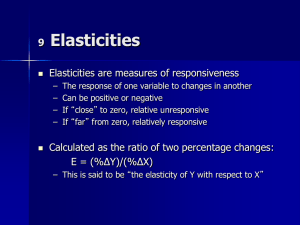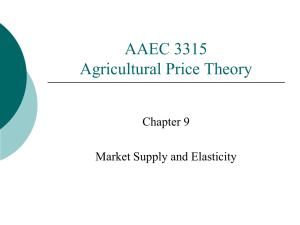Module 48 - Other Elasticities
advertisement
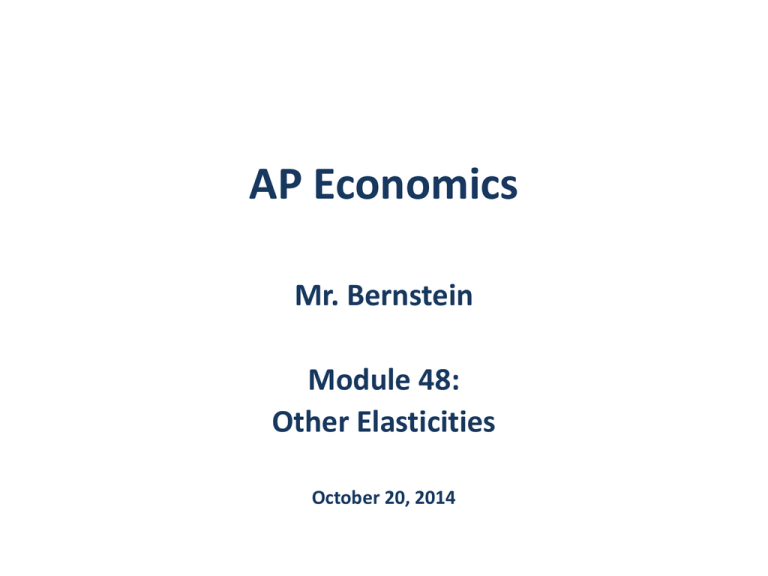
AP Economics Mr. Bernstein Module 48: Other Elasticities October 20, 2014 AP Economics Mr. Bernstein Elasticity can measure responsiveness of other consumer and producer activities • Cross-price elasticity of demand • Income elasticity of demand • Price elasticity of supply 2 AP Economics Mr. Bernstein Who is interested in these elasticities? • • • • Economists Governments Firms Example of cross-price elasticity: How do changes in the price of gas affect car sales? GM and Ford care. • Example of income elasticity: In a recession, how do declining incomes affect hotel occupancy? Holiday Inn and Priceline care. 3 AP Economics Mr. Bernstein Cross-Price Elasticity of Demand • • • • Measures the responsiveness of the demand for good “X” to changes in the price of good “Y” Aka %rDx / %rPy Demand curve for X shifts due to a change in Py Substitutes have positive cross-elasticity • • Compliments have negative cross-elasticity • • A 2% rise in the price of Nikes causes a 4% increase in demand for Adidas; EAdidas, Nikes = 4% / 2% = 2 A 20% rise in the price of gasoline causes a 5% fall in demand for SUVs; E SUVs, gasoline = 20% / -5% = -4 Independent products have zero cross-elasticity • A 10% rise in the price of peanut butter has no effect on demand for SUVs 4 AP Economics Mr. Bernstein Income Elasticity of Demand • • • • Measures the responsiveness of demand for a good to changes in income Aka %r Dx / %rI Demand curve shifts due to change in income; elasticity measures the responsiveness or how much the curve shifts Normal goods have positive income elasticity • • American income declines 2% and purchases of airline tickets to Italy decline 8%; Ei= 8% / 2% = 4 (a high income elasticity typical of luxury items) American income increases 4% and purchases of fresh vegetables increase 1%; Ei = 1% / 4% = .25 (an income-inelastic response typical of necessity items) 5 AP Economics Mr. Bernstein Income Elasticity of Demand, cont. • Inferior goods have negative income elasticity • American income declines 5% and purchases of SPAM increase 4%; Ei= 4% / -5% = -.8 6 AP Economics Mr. Bernstein Price Elasticity of Supply • Law of Supply: When price increases, firms increase quantity supplied • Price Elasticity of Supply follows same formula as Price Elasticity of Demand: Es = %rQs / %rP • Elastic and Inelastic definitions are the same also: • If Es >1, supply is considered elastic • If Es <1, supply is considered inelastic • If Es = 1, supply is considered unit elastic • Elastic is flatter and perfectly elastic is horizontal • Inelastic is steeper and perfectly inelastic is vertical 7 AP Economics Mr. Bernstein Price Elasticity of Supply • What might cause a perfectly inelastic supply curve? • • Even at absurdly high prices, firms will not increase supply Limits to production, perhaps due to technology limits, resource constraints or in the case of farming, seasonal impossibilities 8 AP Economics Mr. Bernstein Factors Influencing Elasticity of Supply • Availability of inputs • • Example: If coal shipments only arrive monthly, a factory cannot quickly increase production when prices increase Time • • • • “Market period” is so short that supply is perfectly inelastic Short-run elasticity of supply is greater than zero Long-run elasticity of supply is greater than short-run elasticity Example: Farmers cannot react to rising soybean prices until the next growing season. 9


